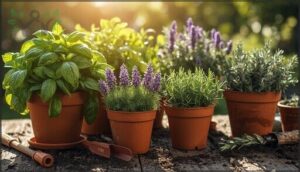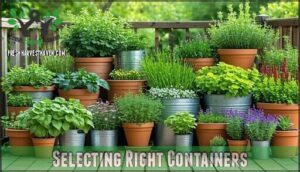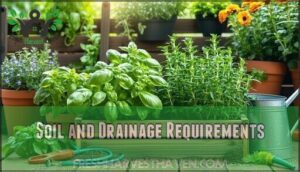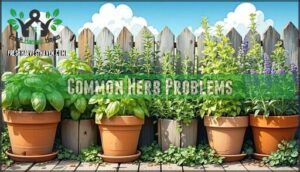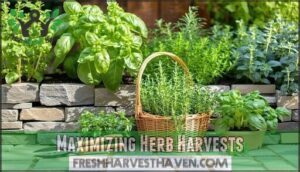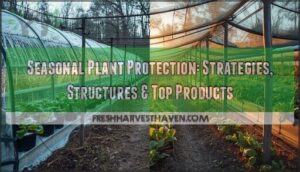This site is supported by our readers. We may earn a commission, at no cost to you, if you purchase through links.
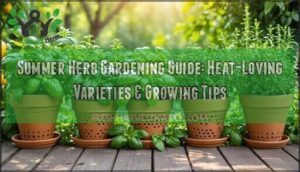
These Mediterranean natives actually prefer warm weather and well-draining soil.
You’ll want containers with drainage holes and potting mix that won’t turn into mud soup after watering.
Most herbs need 6-8 hours of morning sun but appreciate afternoon shade in scorching climates.
Water deeply but infrequently—soggy roots spell disaster faster than a forgotten pizza in the oven.
The secret lies in understanding each herb’s specific needs and timing your harvest correctly.
Table Of Contents
- Key Takeaways
- Choosing Herbs Wisely
- Growing Herbs Successfully
- Container Gardening Tips
- Herb Care and Maintenance
- Common Herb Problems
- Creating Herb Gardens
- Maximizing Herb Harvests
- Frequently Asked Questions (FAQs)
- What herbs are good for summer gardens?
- Can I start an herb garden in the summer?
- What is the best layout for an herb garden?
- What month should you start an herb garden?
- When should I start herb seeds indoors?
- How do I prevent herbs from going dormant?
- Can I grow herbs from grocery store cuttings?
- What herbs attract beneficial insects to gardens?
- How often should I rotate herb plantings?
- Conclusion
Key Takeaways
- Choose heat-loving herbs like basil, oregano, and thyme that thrive in warm weather rather than struggling with summer temperatures
- Master your watering technique by watering deeply but infrequently in the morning, checking soil moisture regularly, and avoiding soggy roots that kill more herbs than neglect
- Set up proper drainage using containers with drainage holes and a well-draining soil mix of equal parts potting soil, compost, and coarse sand
- Harvest strategically by pinching flower buds to prevent bolting, cutting no more than one-third of the plant at once, and timing your harvest in the early morning when oils are most concentrated
Choosing Herbs Wisely
Smart herb selection transforms your summer garden from overwhelming to manageable, especially when you focus on varieties that match your cooking habits and growing conditions.
Choose low-maintenance options like chives, sage, and rosemary if you’re new to gardening, or select cuisine-specific herbs like basil for Italian dishes or cilantro for Mexican flavors to maximize your harvest’s culinary impact.
This approach allows you to create a garden that is both manageable and productive, aligning with your needs and preferences.
Low-Maintenance Herbs
Four drought-tolerant champions make herb gardening effortless: chives, sage, rosemary, and thyme.
These hardy varieties thrive with minimal water and forgive neglect, perfect for busy gardeners.
They’re space-saving powerhouses that deliver maximum flavor with minimal fuss.
Start with these easy-to-grow herbs to build confidence before expanding your summer herb collection, which can include a variety of herbs beyond these drought-tolerant champions.
Herbs for Specific Cuisines
While low-maintenance herbs offer simplicity, choosing varieties that match your cooking style transforms your garden into a culinary powerhouse.
Italian herbs like basil, oregano, and rosemary dominate Mediterranean dishes, while Mexican herbs including cilantro and epazote bring authentic flavors to salsas.
Indian spices like cilantro and coriander seeds enhance curries, and French cuisine benefits from tarragon’s distinctive taste.
Asian herbs add complexity to stir-fries and soups. Understanding the proper herb storage methods is essential for maintaining their flavor and aroma in various dishes.
Growing Herbs Successfully
Once you’ve chosen your herbs, success depends on mastering the fundamentals. Start with high-quality, well-draining potting soil that’s loose rather than compacted. Your herb selection should guide your garden layout—place taller plants like rosemary in back, shorter ones like thyme in front.
Most herbs crave full sun, needing six to eight hours daily for ideal growth. Soil quality makes or breaks your herb garden. Mix equal parts topsoil, compost, and coarse sand for perfect drainage.
Add earthworm castings for extra nutrients—your herbs will thank you with robust growth. Water management requires a delicate touch. Tender-stemmed herbs like basil need consistent moisture, while woody herbs prefer drier conditions.
Keep individual watering notes for each plant; they’re as unique as fingerprints. Pest management starts with prevention. Healthy, vigorous herbs resist insects better than stressed plants.
Monitor regularly for aphids and spider mites, treating early with organic soap spray when needed. This approach ensures your herb garden remains healthy and thriving, with each plant receiving the care it needs to flourish.
Container Gardening Tips
Container gardening offers the perfect solution for growing herbs in limited spaces while maintaining complete control over growing conditions.
You’ll discover that proper container selection, soil preparation, and strategic placement can transform any sunny spot into a thriving herb garden that rivals traditional in-ground plantings, with complete control being a key factor.
Selecting Right Containers
Choose containers that break free from traditional gardening constraints—your herbs don’t need massive pots to thrive.
Small containers, big flavors—your herbs thrive in compact spaces.
Container size matters: 8-12 inches wide works perfectly for most herbs, while planter depth should reach 6-12 inches for healthy root development.
Natural pot materials like cedar, steel, and terra cotta outperform plastic alternatives.
Essential drainage holes prevent waterlogged disasters that kill more herb containers than neglect ever could.
Proper container gardening techniques, including soil preparation tips, are vital for promoting healthy herb growth and ensuring the success of your gardening efforts.
Soil and Drainage Requirements
Well-draining potting soil forms your herb garden’s foundation.
You’ll want a loose, airy soil mix for herbs that prevents waterlogged roots—the kiss of death for most varieties.
Create your perfect herb garden soil by combining equal parts quality potting soil, compost, and coarse sand.
This magical trio guarantees proper drainage systems while maintaining adequate water retention and organic matter for healthy growth.
Understanding the importance of well draining soil is vital for a thriving herb garden.
Sunlight and Watering Needs
Most herbs need 6-8 sunlight hours daily for peak growth.
Mediterranean varieties like rosemary thrive in full sun, while mint tolerates partial shade.
Water schedules vary by species – leafy herbs need watering every 2-3 days, drought-tolerant varieties weekly.
Monitor soil moisture regularly and adjust herb hydration based on light exposure and temperature.
Effective garden watering systems, such as those using proper irrigation methods, can help maintain ideal soil conditions for herb growth.
Herb Care and Maintenance
Your herb garden’s success depends on consistent watering and smart feeding practices that match each plant’s specific needs.
Regular pruning and proper harvesting techniques will keep your herbs producing fresh leaves all season long while preventing them from going to seed too early.
Watering and Fertilizing
Perfect soil moisture and smart water schedules keep your herbs thriving through summer’s heat.
Water at sunrise when plants absorb moisture best and heat hasn’t stressed tender leaves.
Most herbs need about one inch weekly, but container plants dry faster and require daily checks.
Here’s your herb watering needs breakdown:
- Check soil moisture – Water when top inch feels dry
- Time irrigation methods – Water at 6 AM for best absorption
- Match fertilizer types to growth stage – Light feeding monthly
- Balance nutrients – Organic options prevent salt buildup in soil mix for herbs
Your water management system directly impacts nutrient balance and overall plant health.
Understanding proper soil preparation techniques is essential for healthy herb growth.
Pruning and Harvesting
Regular herb trimming keeps your plants productive and prevents them from going to seed.
Sharp pruning tools make clean cuts that heal quickly, reducing disease risk.
Harvest timing matters—pick leaves in early morning when oils are concentrated.
For leaf pruning, pinch stems just above leaf nodes to encourage bushy growth.
Never harvest more than one-third of the plant at once, and remember that sharp pruning tools and proper harvest timing are crucial for the health of your herbs.
Common Herb Problems
Even experienced gardeners encounter frustrating herb problems that can puzzle them for weeks.
Your summer herbs might develop yellow leaves, bolt unexpectedly, or struggle with extreme heat despite your best care efforts.
Yellow Leaves and Bolting
Even well-maintained herbs can develop yellow leaves and bolting, disrupting your summer harvest.
These issues often signal Water Stress, Nutrient Deficiency, or environmental triggers affecting Soil Quality and plant health.
Here’s your troubleshooting checklist for yellow leaves and Bolting Prevention:
- Check watering patterns – Overwatering causes Leaf Damage through root suffocation, while underwatering creates stress
- Test soil drainage – Poor drainage leads to waterlogged roots and yellowing foliage
- Monitor for pests – Aphids and spider mites can cause slowed growth and discoloration
- Pinch flower buds – Regular removal prevents bolting and maintains tender leaves for harvest
Both problems reduce herb quality, but quick intervention restores healthy summer herb care and maximizes your herb gardening success.
Understanding the reasons behind herb bolting issues is essential for effective prevention and management.
Extreme Temperature Effects
When scorching summer temperatures climb above 90°F, your herbs face heat stress that can stunt growth and reduce flavor.
Extreme cold snaps below 50°F shock warm-weather plants, causing wilting and leaf drop.
Smart temperature control and frost protection keep your garden thriving through climate challenges.
| Temperature Range | Herb Response | Protection Strategy |
|---|---|---|
| Above 90°F | Heat stress, wilting, sun scorch | Shade cloth, mulching, frequent watering |
| 50-70°F | Ideal growth zone | Monitor for sudden changes |
| Below 50°F | Shock, leaf drop, dormancy | Row covers, indoor relocation |
Climate resilience comes from choosing drought-tolerant plants and implementing proper summer herb care techniques for your heat-loving varieties.
Creating Herb Gardens
You can create herb gardens in various locations, from traditional in-ground beds to creative windowsill setups that maximize your growing space.
Whether you choose raised beds for better drainage or indoor containers for year-round harvests, the key is matching your garden style to your available space and growing conditions, using complete concepts to guide your decisions.
In-Ground Beds and Raised Beds
In-ground beds and raised beds offer different advantages for your summer herb garden. Choose based on your soil quality, drainage needs, and physical accessibility preferences.
Bed Preparation and Garden Layout Tips:
- Soil Amendments: Mix compost and coarse sand into clay soil for better drainage, especially for Mediterranean herbs like rosemary and thyme
- Raised Bed Tips: Build 8-12 inches high using cedar or steel materials, filling with equal parts topsoil, compost, and paver sand
- In-Ground Designs: Test soil pH and amend with organic matter, creating separate zones for moisture-loving versus drought-tolerant herbs
- Garden Layout: Place taller herbs like fennel in back, shorter ones like thyme in front, grouping plants by similar water needs
Understanding optimal raised bed designs is essential for a successful herb garden.
Windowsill and Indoor Gardens
Your indoor herb garden can thrive year-round with proper setup.
Choose south-facing windows for maximum sunlight, or supplement with grow lights for darker spaces.
Window boxes and herb shelves maximize vertical growing space.
Select compact varieties like basil and chives for indoor pots, these micro gardens bring fresh flavors to your kitchen regardless of outdoor weather conditions, making them a great addition to any kitchen.
Companion Planting Benefits
Beyond windowsills, companion planting transforms your summer herb gardening into a thriving ecosystem.
Plant basil with parsley for 20% higher yields through nutrient sharing. Marigolds reduce pest control issues by 30% while boosting soil health.
This organic gardening approach creates plant diversity that attracts pollinator-friendly insects, enhancing growth naturally without chemicals.
Maximizing Herb Harvests
You’ll maximize your herb garden’s productivity by learning proper harvesting techniques that encourage continuous growth throughout the summer season.
Strategic timing and storage methods will transform your fresh herbs into year-round culinary treasures.
Harvesting Techniques
Perfect timing creates perfect flavor—harvest your herbs in the morning after dew evaporates.
Use sharp, clean shears for stem harvesting and leaf pruning. Practice flower pinching to prevent bolting and maintain leaf quality.
Cut stems at 45-degree angles, removing no more than one-third of the plant. These herb harvesting techniques guarantee continuous growth throughout your summer herb gardening season.
Understanding proper harvesting methods is vital for maximizing yields and flavor.
Storage and Preservation Methods
Once you’ve harvested your herbs, proper storage transforms your summer bounty into year-round flavor.
Freezing herbs in ice cube trays with water or oil preserves 95% of their original taste.
Air drying works best for sturdy varieties like rosemary, while herb oils and infused vinegars capture essence beautifully.
Choose your preservation method based on each herb’s characteristics. To maintain freshness, consider using herb storage solutions that are airtight and durable.
Using Herbs in Various Dishes
Once you’ve mastered proper storage techniques, your culinary herbs become flavor powerhouses ready to transform ordinary meals into extraordinary experiences.
Fresh basil elevates pasta dishes while mint brightens summer beverages and fruit salads.
Cilantro adds zest to salsas and Asian stir-fries, and chives provide onion-like punch to eggs and potatoes.
Match herb pairings with complementary flavors—rosemary with roasted vegetables, thyme with grilled meats, to create vibrant flavor profiles in countless dish enhancement possibilities, and your herb recipes will showcase these extraordinary experiences with transform ordinary meals.
Frequently Asked Questions (FAQs)
What herbs are good for summer gardens?
You’ll love growing basil, mint, cilantro, and chives in summer. These heat-tolerant herbs thrive in containers or garden beds with full sun and well-draining soil for fresh flavors.
Can I start an herb garden in the summer?
You can absolutely start an herb garden in summer.
Many herbs actually thrive in warm weather. Choose heat-tolerant varieties like basil, oregano, and thyme.
Make certain adequate watering and consider afternoon shade.
What is the best layout for an herb garden?
Place taller herbs like rosemary in back, shorter ones like thyme in front. Group moisture-loving herbs together, separate from drought-tolerant varieties. This layout maximizes sunlight exposure and simplifies watering schedules.
What month should you start an herb garden?
Spring’s your golden ticket to herb garden success!
Start seeds indoors 6-8 weeks before your last frost date, then transplant outdoors after soil warms to 60°F consistently—typically late April through May.
When should I start herb seeds indoors?
Start herb seeds indoors 6-8 weeks before your last frost date. This timing gives seedlings strength to transplant outdoors when temperatures stabilize, ensuring robust growth throughout the growing season.
How do I prevent herbs from going dormant?
Like a gardener tending an eternal flame, you’ll keep herbs thriving through strategic care.
Maintain consistent watering, provide adequate sunlight, and harvest regularly to prevent flowering.
Indoor overwintering and proper nutrition guarantee year-round growth.
Can I grow herbs from grocery store cuttings?
You can propagate herbs like basil, mint, and cilantro from fresh grocery store cuttings.
Remove lower leaves, place stems in water, and wait for roots to develop before transplanting into soil, which is a process that involves complete concepts of herb propagation.
What herbs attract beneficial insects to gardens?
A flourishing garden begins with one wise decision: you’ll attract beneficial insects by planting herbs like hyssop, sage, and borage that naturally repel pests while drawing in pollinators and predators.
How often should I rotate herb plantings?
Most herbs don’t require rotation since they’re typically annuals or short-lived perennials.
However, you’ll want to refresh your soil annually and switch planting locations every 2-3 years to prevent soil depletion and disease buildup.
Conclusion
Like a well-tended garden that rewards patient cultivation, your summer herb gardening guide journey transforms ordinary windowsills into aromatic sanctuaries.
You’ve learned to select heat-tolerant varieties, provide proper drainage, and master the delicate balance of sunlight and water.
These Mediterranean champions thrive when you understand their specific needs.
Remember, successful harvesting requires timing and technique.
Whether you’re growing basil for fresh pesto or oregano for pizza night, consistent care yields flavorful rewards that’ll elevate your culinary adventures with fresh ingredients.
- https://www.ourcoop.com/news/rural-lifestyle/embrace-the-summer-with-fresh-herbs
- https://www.dripworks.com/blog/top-8-summer-herbs-to-grow-in-your-garden
- https://www.gardeningknowhow.com/edible/herbs/hgen/herb-garden-tips-and-tricks.htm
- https://www.falconslanding.org/blog/growing-and-cooking-summers-herbs
- https://www.lsuagcenter.com/profiles/rbogren/articles/page1526045776332

